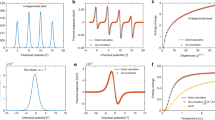Abstract
The understanding of mesoscopic transport has now attained an ultimate simplicity. Indeed, orthodox quantum kinetics would seem to say little about mesoscopics that has not been revealed — nearly effortlessly — by more popular means. Such is far from the case, however. The fact that kinetic theory remains very much in charge is best appreciated through the physics of a quantum point contact. While discretization of its conductance is viewed as the exclusive result of coherent, single-electron-wave transmission, this does not begin to address the paramount feature of all metallic conduction: dissipation. A perfect quantum point contact still has finite resistance, so its ballistic carriers must dissipate the energy gained from the applied field. How do they manage that? The key is in standard many-body quantum theory, and its conservation principles.
Similar content being viewed by others
References
Y Imry, Introduction to mesoscopic physics, 2nd edition (Oxford University Press, Oxford, 2002)
Y Imry and R Landauer, Rev. Mod. Phys. 71, S306 (1999)
Y M Blanter and M Büttiker, Phys. Rep. 336, 1 (2000)
G D Mahan, Many-particle physics, 3rd edition (Plenum, New York, 1990) ch. 7
J Davies, Physics of low-dimensional semiconductors: An introduction (Cambridge University Press, Cambridge, 1998) p. 199ff
N Agraït, A Levy Yeyati and J M van Ruitenbeek, Phys. Rep. 377, 81 (2003); see section IIID5
M P Das and F Green, J. Phys.: Condens. Matter 17, V13 (2005)
W R Frensley, in Heterostructures and quantum devices edited by W R Frensley and N G Einspruch (Academic, San Diego, 1994) ch. 9
M P Das and F Green, J. Phys.: Condens. Matter 15, L687 (2003)
F Green and M P Das, J. Phys.: Condens. Matter 12, 5233 (2000); 12, 5251 (2000)
M Reznikov, M Heiblum, H Shtrikman and D Mahalu, Phys. Rev. Lett. 75, 3340 (1995)
F Green, J S Thakur and M P Das, Phys. Rev. Lett. 92, 156804 (2004)
D Pines and P Nozières, The theory of quantum liquids (Benjamin, New York, 1966)
R Kubo, M Toda and M Hashitsume, Statistical physics II: Non-equilibrium statistical mechanics, 2nd edition (Springer, Berlin, 1991)
F Sols, Phys. Rev. Lett. 67, 2874 (1991)
W Magnus and W Schoenmaker, Quantum transport in sub-micron devices: A theoretical introduction (Springer, Berlin, 2002)
J S Thakur, F Green and M P Das, Int. J. Mod. Phys. B18, 1479 (2004)
M P Das, J S Thakur and F Green, arXiv preprint cond-mat/0401134 (2004); Mesoscopic transport: The electron gas sum-rules in a driven quantum point contact, In: Condensed Matter Theories edited by M Belkacem and P M Dinh (Nova Science Publishers, New York, 2005) vol. 19, pp. 161–172
F Green and M P Das, in Noise and fluctuations control in electronic devices edited by A A Balandin (American Scientific Publishers, Stevenson Ranch, 2002) pp. 31–48
Author information
Authors and Affiliations
Rights and permissions
About this article
Cite this article
Das, M.P., Green, F. What is novel in quantum transport for mesoscopics?. Pramana - J Phys 67, 73–83 (2006). https://doi.org/10.1007/s12043-006-0038-5
Issue Date:
DOI: https://doi.org/10.1007/s12043-006-0038-5
Keywords
- Mesoscopic systems
- quantum transport
- many-body kinetic theory
- conductance and noise
- quantum point contacts




